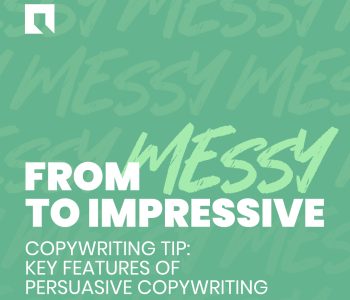
Recently, we talked about embracing the importance of messy brainstorming. Now that your ideas are on the page, it’s time to structure your brainstorming into quality content using the key features of persuasive copywriting that captures attention and inspires action.
Let’s take a close look at the elements that are essential for guiding your audience toward desired outcomes: buying your product, using your services, joining your club.
Well-Defined Issue
Persuasive copywriting begins with a clearly stated claim so your audience knows exactly what the focus is and what’s at stake. In marketing, for instance, this might involve identifying a consumer need, such as “choosing the right pet food” or “what’s the best fast food meal for my money.”
Clear Position
Once the issue is defined, you need to clearly establish your stance on the subject. In persuasive writing, ambiguity weakens your message. Your position should be firm, whether you’re advocating for a product, service, or idea. In product marketing, this could mean positioning a product as the best solution to the problem defined in your claim.
Convincing Argument
To persuade your audience effectively, you must provide strong evidence to support your position. This could include facts, statistics, expert opinions, customer testimonials, or compelling examples. The goal is to demonstrate how your solution, idea, or product directly addresses the defined issue.
Appropriate Tone for Audience/Brand
Tone is the emotional and intellectual approach you take when speaking to your target audience, and it must align with the brand’s identity. Think of the tone as setting the mood for how a message is received. For example, for a luxury brand, you would use elegant, refined language to emphasize exclusivity and sophistication, while a casual brand may call for a warm and conversational tone that feels approachable and friendly.
Comparative Analysis
When appropriate for your copywriting task, addressing your competitors is a powerful strategy in persuasive writing because it shows you’ve considered alternative perspectives and are prepared to refute them. This is particularly important in markets where you need to differentiate your product or idea from others by highlighting your brand’s strengths while explaining why competing options fall short.
For instance, if you’re arguing that making coffee at home is better than buying coffee at a shop, you can acknowledge common reasons people prefer buying coffee at a shop (no prep time; variety and seasonal options; social experience) and then refute those points and emphasize the benefits of making coffee at home (cost-efficient; easy customization; time saver). This approach shows you’re aware of the debate, adding credibility to your claim.
Call to Action
A Call to Action is the final piece of persuasive content that prompts your audience/customers to take a specific next step; therefore, it needs to be clear, direct, and aligned with the overall goal of your content. In marketing, the CTA turns passive readers into active participants, whether they’re buying a product, signing up for a newsletter, or joining a cause. Often, CTAs create a sense of urgency or exclusivity, such as with the stereotypical “Act now!” used in As Seen on TV product commercials.
By incorporating these key elements of persuasive copywriting, you’ll build trust, establish brand credibility, and effectively address your audience’s needs, ensuring the message aligns with both the brand’s identity and the audience’s expectations.

